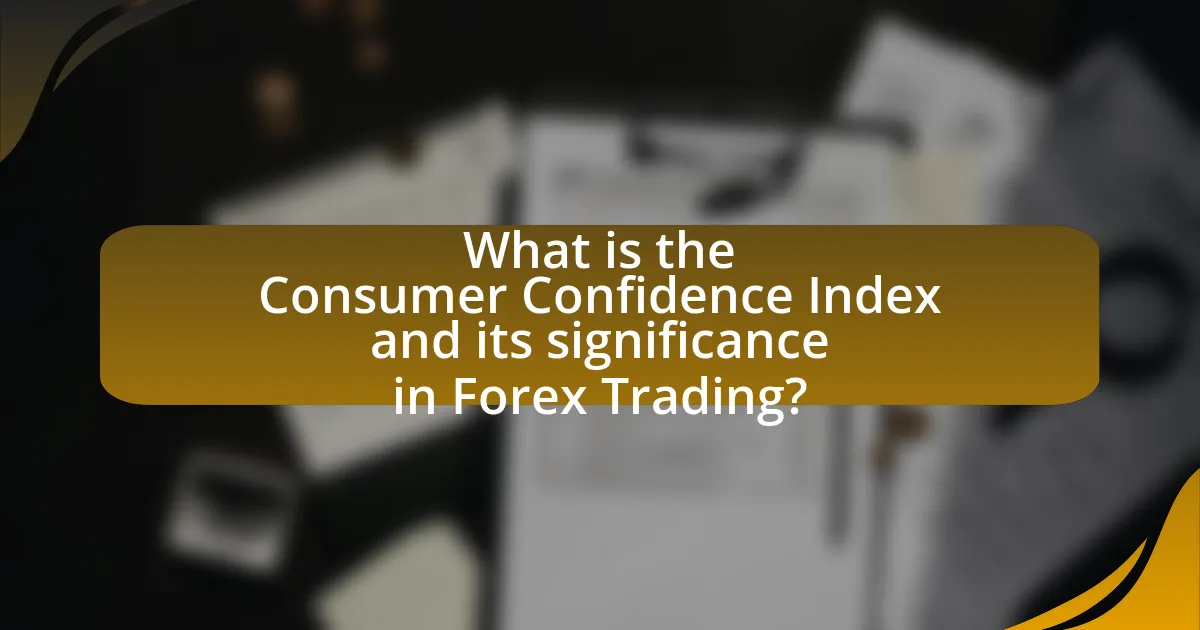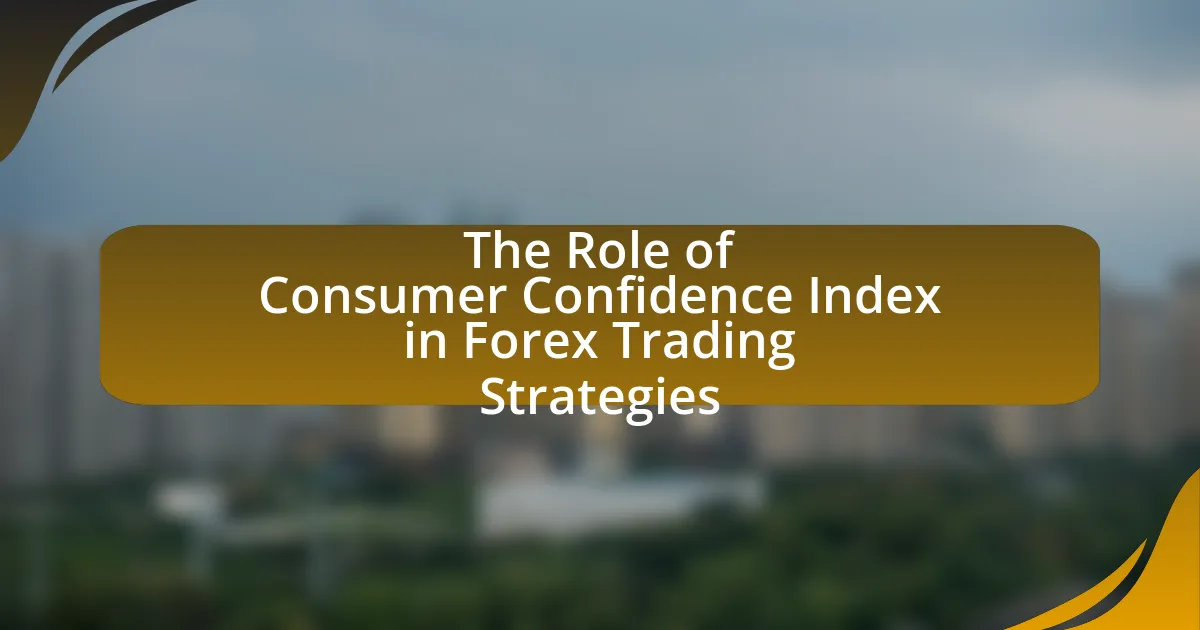The Consumer Confidence Index (CCI) is a crucial economic indicator that gauges consumer optimism regarding the economy and personal financial situations, significantly impacting Forex trading strategies. A higher CCI typically correlates with increased consumer spending and a stronger currency, while a declining CCI may indicate economic uncertainty and a weaker currency. The article explores how the CCI is calculated, its key components, and its relationship with other economic indicators, emphasizing its importance for traders in predicting market movements. Additionally, it discusses best practices for utilizing the CCI in trading strategies, potential risks, and common pitfalls to avoid, providing a comprehensive understanding of its role in Forex markets.

What is the Consumer Confidence Index and its significance in Forex Trading?
The Consumer Confidence Index (CCI) is an economic indicator that measures the degree of optimism consumers feel about the overall state of the economy and their personal financial situations. The significance of the CCI in Forex trading lies in its ability to influence currency values; a higher CCI typically indicates increased consumer spending, which can lead to economic growth and a stronger currency. For instance, when the CCI rises, it often results in a bullish sentiment for the currency associated with that economy, as traders anticipate higher interest rates and economic expansion. Conversely, a declining CCI may signal economic uncertainty, leading to a weaker currency as traders adjust their positions based on expected economic performance.
How is the Consumer Confidence Index calculated?
The Consumer Confidence Index (CCI) is calculated through a survey that measures the degree of optimism consumers feel about the overall state of the economy and their personal financial situation. Specifically, the Conference Board conducts this survey monthly, polling approximately 3,000 households in the United States. The survey includes questions about consumers’ perceptions of current economic conditions and their expectations for the next six months regarding business conditions, employment, and income. The responses are then aggregated and indexed to create the CCI, which is expressed as a number relative to a base year, typically set at 1985, where the index value is 100. This methodology ensures that the CCI reflects changes in consumer sentiment over time, providing valuable insights into economic trends.
What are the key components of the Consumer Confidence Index?
The key components of the Consumer Confidence Index (CCI) are the present situation index and the expectations index. The present situation index measures consumers’ perceptions of current economic conditions, including their assessment of job availability and business conditions. The expectations index gauges consumers’ outlook on the economy over the next six months, focusing on anticipated changes in employment, income, and overall economic conditions. These components are derived from surveys conducted by organizations such as The Conference Board, which collects data from thousands of households to assess consumer sentiment and economic outlook.
How do economic indicators influence the Consumer Confidence Index?
Economic indicators significantly influence the Consumer Confidence Index (CCI) by shaping consumer perceptions of economic stability and future financial prospects. For instance, indicators such as unemployment rates, inflation, and GDP growth directly affect consumer sentiment; when unemployment is low and GDP is rising, consumers tend to feel more secure in their financial situations, leading to higher confidence levels reflected in the CCI. Conversely, high inflation or rising unemployment can erode confidence, resulting in a lower CCI. Historical data shows that fluctuations in the CCI often correlate with changes in these economic indicators, demonstrating their critical role in shaping consumer attitudes and spending behaviors.
Why is the Consumer Confidence Index important for Forex traders?
The Consumer Confidence Index (CCI) is important for Forex traders because it serves as a key indicator of consumer sentiment and economic health, influencing currency value fluctuations. A high CCI typically indicates that consumers are optimistic about the economy, which can lead to increased spending and economic growth, positively impacting a country’s currency. Conversely, a low CCI suggests pessimism, potentially leading to decreased spending and economic contraction, which can weaken the currency. Historical data shows that significant changes in the CCI often correlate with shifts in currency pairs, making it a valuable tool for traders to anticipate market movements and adjust their strategies accordingly.
How does consumer confidence impact currency values?
Consumer confidence significantly impacts currency values by influencing investor sentiment and economic expectations. When consumer confidence is high, it typically leads to increased spending and investment, which can strengthen a country’s economy and, consequently, its currency. For instance, a rise in the Consumer Confidence Index often correlates with a stronger domestic currency, as seen in the U.S. dollar’s appreciation following positive consumer sentiment reports. Conversely, low consumer confidence can lead to decreased spending, weakening the economy and depreciating the currency. Historical data shows that fluctuations in consumer confidence directly affect exchange rates, highlighting its critical role in forex trading strategies.
What historical trends show the relationship between consumer confidence and Forex markets?
Historical trends indicate a strong inverse relationship between consumer confidence and Forex markets, particularly in how currency values fluctuate in response to consumer sentiment. For instance, during periods of high consumer confidence, such as in the late 1990s and mid-2000s, currencies like the US dollar often appreciated due to increased spending and investment. Conversely, during economic downturns, such as the 2008 financial crisis, consumer confidence plummeted, leading to a depreciation of the dollar and other currencies as investors sought safer assets. Data from the University of Michigan’s Consumer Sentiment Index shows that significant drops in consumer confidence correlate with declines in currency values, reinforcing the notion that Forex markets react sensitively to shifts in consumer sentiment.

How can traders utilize the Consumer Confidence Index in their strategies?
Traders can utilize the Consumer Confidence Index (CCI) by analyzing its trends to gauge consumer sentiment and predict market movements. The CCI reflects how optimistic or pessimistic consumers are regarding the economy, which can influence spending and investment decisions. For instance, a rising CCI often indicates increased consumer spending, leading to potential currency appreciation, while a declining CCI may suggest economic contraction, prompting traders to consider short positions. Historical data shows that significant shifts in the CCI correlate with changes in GDP growth, making it a valuable indicator for traders to anticipate economic trends and adjust their strategies accordingly.
What strategies can be developed using the Consumer Confidence Index?
Strategies that can be developed using the Consumer Confidence Index (CCI) include trend analysis, market sentiment assessment, and timing of entry and exit points in Forex trading. By analyzing the CCI, traders can gauge consumer sentiment, which often correlates with economic performance and currency strength. For instance, a rising CCI typically indicates increased consumer spending and economic growth, leading traders to favor currencies from countries with improving economic conditions. Conversely, a declining CCI may signal economic downturns, prompting traders to sell or avoid currencies from those regions. Historical data shows that significant shifts in the CCI often precede changes in currency value, making it a valuable tool for predicting market movements.
How can traders interpret Consumer Confidence Index reports for decision-making?
Traders can interpret Consumer Confidence Index (CCI) reports as indicators of consumer sentiment, which directly influences economic activity and market trends. A rising CCI suggests increased consumer optimism, often leading to higher spending and potential economic growth, prompting traders to consider bullish positions in currencies associated with strong economic performance. Conversely, a declining CCI indicates consumer pessimism, which may lead to reduced spending and economic contraction, encouraging traders to adopt bearish positions in those currencies. Historical data shows that significant shifts in the CCI often precede changes in GDP growth, making it a valuable tool for forecasting market movements and informing trading strategies.
What are the risks of relying on the Consumer Confidence Index in Forex trading?
Relying on the Consumer Confidence Index (CCI) in Forex trading poses several risks, primarily due to its inherent volatility and potential for misinterpretation. The CCI reflects consumer sentiment, which can change rapidly based on economic events, leading to sudden market fluctuations that may not align with actual economic conditions. For instance, a spike in consumer confidence might not translate into increased spending if external factors, such as geopolitical tensions or inflation, are at play. Additionally, traders may overemphasize the CCI, neglecting other critical indicators like employment rates or GDP growth, which provide a more comprehensive view of economic health. This overreliance can result in poor trading decisions and increased exposure to market risks. Historical data shows that significant market movements often occur following CCI releases, indicating that traders who base their strategies solely on this index may face unexpected losses.
How does the Consumer Confidence Index interact with other economic indicators?
The Consumer Confidence Index (CCI) interacts with other economic indicators by reflecting consumer sentiment, which influences spending and investment decisions. A higher CCI typically correlates with increased consumer spending, which can lead to higher GDP growth, while a lower CCI may indicate reduced spending and potential economic contraction. For instance, the CCI often moves in tandem with retail sales data; when consumer confidence rises, retail sales tend to increase, supporting economic expansion. Additionally, the CCI can impact stock market performance, as investor sentiment is often influenced by consumer outlook. Historical data shows that significant shifts in the CCI precede changes in unemployment rates and inflation, making it a valuable predictor in economic forecasting.
What is the relationship between the Consumer Confidence Index and GDP growth?
The Consumer Confidence Index (CCI) is positively correlated with GDP growth, indicating that higher consumer confidence typically leads to increased consumer spending, which drives economic expansion. When consumers feel optimistic about their financial situation and the economy, they are more likely to spend money, contributing to higher GDP figures. Historical data supports this relationship; for instance, during periods of rising CCI, such as in 2010-2011, the U.S. GDP experienced growth rates above 2%, reflecting the impact of consumer sentiment on economic performance.
How do interest rates correlate with changes in the Consumer Confidence Index?
Interest rates inversely correlate with changes in the Consumer Confidence Index (CCI). When interest rates rise, consumer confidence typically declines as borrowing costs increase, leading to reduced spending and investment. Conversely, lower interest rates tend to boost consumer confidence, as cheaper borrowing encourages spending and economic activity. Historical data from the Federal Reserve shows that during periods of rising interest rates, such as in the late 1970s, the CCI often fell, indicating a negative relationship. This correlation is crucial for Forex trading strategies, as shifts in consumer confidence can influence currency values based on anticipated economic performance.

What are the best practices for incorporating the Consumer Confidence Index into Forex trading?
The best practices for incorporating the Consumer Confidence Index (CCI) into Forex trading include analyzing the index’s trends, correlating it with currency movements, and using it alongside other economic indicators. Traders should monitor the CCI release dates and assess the index’s impact on market sentiment, as a rising CCI typically indicates increased consumer spending, which can strengthen a currency. Historical data shows that significant changes in the CCI often precede currency fluctuations; for instance, a 10-point increase in the CCI has historically correlated with a 0.5% appreciation in the U.S. dollar against major currencies. Additionally, integrating the CCI with technical analysis tools can enhance decision-making, allowing traders to identify entry and exit points more effectively.
How can traders effectively monitor the Consumer Confidence Index?
Traders can effectively monitor the Consumer Confidence Index (CCI) by regularly reviewing its release schedule and analyzing the data provided by the Conference Board, which publishes the index monthly. The CCI reflects consumer sentiment and can influence market trends; for instance, a rising index often correlates with increased consumer spending, which can positively impact economic growth and currency strength. Historical data shows that significant changes in the CCI can lead to volatility in Forex markets, making it crucial for traders to track these fluctuations closely. Additionally, utilizing economic calendars and financial news platforms can help traders stay informed about upcoming CCI releases and related economic indicators, allowing for timely trading decisions based on consumer sentiment trends.
What tools and resources are available for tracking the Consumer Confidence Index?
The primary tools and resources available for tracking the Consumer Confidence Index (CCI) include government reports, financial news websites, and economic data platforms. The Conference Board publishes the CCI monthly, providing detailed reports that can be accessed through their official website. Additionally, financial news outlets like Bloomberg and Reuters offer real-time updates and analysis on the CCI, making them valuable resources for traders. Economic data platforms such as Trading Economics and Investing.com also track the CCI, presenting historical data and forecasts that assist in understanding consumer sentiment trends. These resources collectively enable traders to make informed decisions based on consumer confidence levels, which can significantly impact Forex trading strategies.
How can traders adjust their strategies based on Consumer Confidence Index trends?
Traders can adjust their strategies based on Consumer Confidence Index (CCI) trends by analyzing shifts in consumer sentiment to predict market movements. When the CCI indicates rising consumer confidence, traders may consider increasing their positions in riskier assets, anticipating economic growth and higher consumer spending. Conversely, if the CCI shows declining confidence, traders might reduce exposure to equities and increase positions in safe-haven currencies, as lower consumer confidence often correlates with economic downturns. Historical data supports this approach; for instance, during periods of high consumer confidence, such as in 2018, stock markets generally experienced upward trends, while declines in the CCI in 2020 coincided with market volatility and downturns.
What common mistakes should traders avoid when using the Consumer Confidence Index?
Traders should avoid overreacting to short-term fluctuations in the Consumer Confidence Index (CCI). This index measures consumer sentiment and can influence market trends, but traders often misinterpret temporary changes as long-term signals. For instance, a sudden drop in the CCI may lead traders to prematurely sell assets, despite historical data showing that consumer confidence can rebound quickly. Additionally, traders should not ignore the broader economic context; relying solely on the CCI without considering other economic indicators, such as employment rates or inflation, can lead to misguided trading decisions. Historical analysis indicates that the CCI is more effective when used in conjunction with other data, as it provides a more comprehensive view of economic health.
How can misinterpretation of the Consumer Confidence Index lead to trading errors?
Misinterpretation of the Consumer Confidence Index can lead to trading errors by causing traders to make decisions based on inaccurate assessments of consumer sentiment. When traders misread the index, they may overestimate or underestimate economic conditions, leading to misguided trades. For instance, if a trader interprets a slight decline in the index as a sign of economic weakness, they might sell assets prematurely, resulting in losses. Historical data shows that significant fluctuations in the Consumer Confidence Index often precede market movements; thus, incorrect interpretations can misalign trading strategies with actual market trends.
What are the pitfalls of over-relying on the Consumer Confidence Index in Forex trading?
Over-relying on the Consumer Confidence Index (CCI) in Forex trading can lead to significant pitfalls, including misinterpretation of market sentiment and neglect of other critical economic indicators. The CCI reflects consumer optimism or pessimism, but it does not account for real-time economic changes, which can result in traders making decisions based solely on outdated or incomplete information. For instance, during periods of economic volatility, a high CCI may not accurately predict currency strength, as seen in the 2008 financial crisis when consumer confidence was high despite underlying economic instability. Additionally, traders may overlook factors such as interest rates, inflation, and geopolitical events, which can have a more immediate impact on currency values. This narrow focus can lead to poor trading decisions and increased risk exposure.
